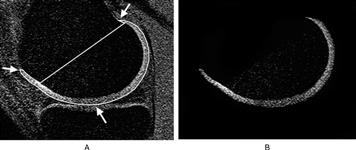Changes in knee cartilage volume and serum COMP concentration after running exercise |
| |
| Authors: | Kersting Uwe G Stubendorff Johann J Schmidt Matthias C Brüggemann Gert-Peter |
| |
| Affiliation: | Department of Sport and Exercise Science, University of Auckland, New Zealand. u.kersting@auckland.ac.nz |
| |
| Abstract: | 
OBJECTIVE: Investigate the relationship between running induced joint loading at the knee, changes in cartilage volume and serum cartilage oligomeric matrix protein (COMP) concentration. DESIGN: Serum COMP levels and knee cartilage volumes of experienced runners were tested before and after running. Joint loading was determined using a biomechanical model of the lower extremity. BACKGROUND: To date no biomechanical rationale has been identified to explain the role of mechanical load in the aetiology of running injuries. METHODS: Blood samples and magnetic resonance imaging scans were taken before and following a 1h training run. Knee cartilage volume and serum COMP concentration were determined. Individual knee joint loading parameters were calculated from positional data and ground reaction forces. Electromyography was employed to quantify activity of main muscle groups crossing the knee joint. RESULTS: Changes in cartilage volume and COMP showed significant correlations. Net joint forces did not explain the differences in cartilage changes. Multiple regression revealed that resting COMP, COMP change after exercise and the time of co-activation of flexor and extensor muscles explain the variance of cartilage volume changes. CONCLUSIONS: Muscular co-activation was the main mechanical parameter related to cartilage changes. The current investigation elucidates the interaction of factors related to cartilage degeneration on an individual basis. Applications to altered loading conditions such as equipment or training methods offer an auspicious way of quantifying effects of interventions. |
| |
| Keywords: | |
| 本文献已被 ScienceDirect PubMed 等数据库收录! |

